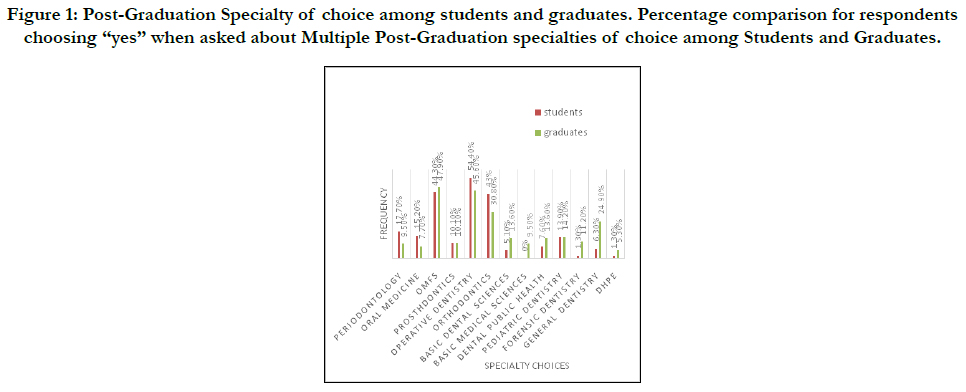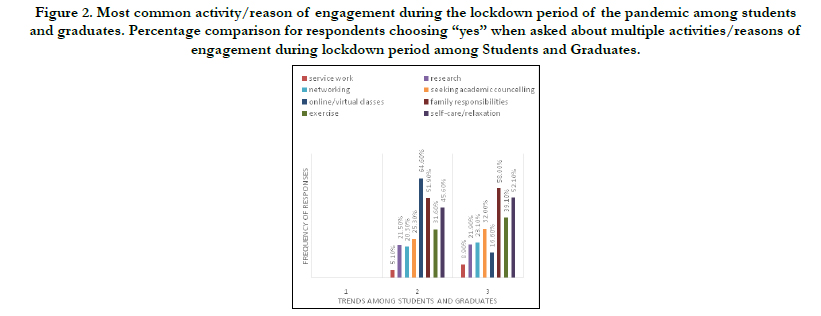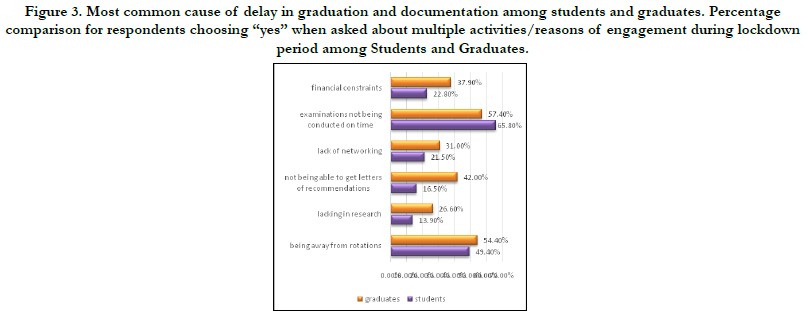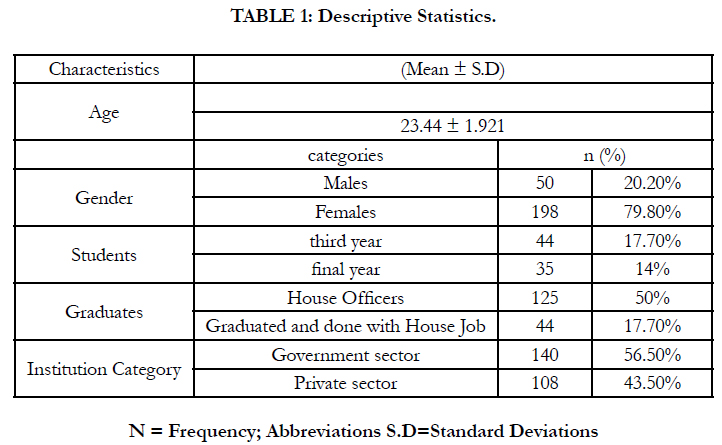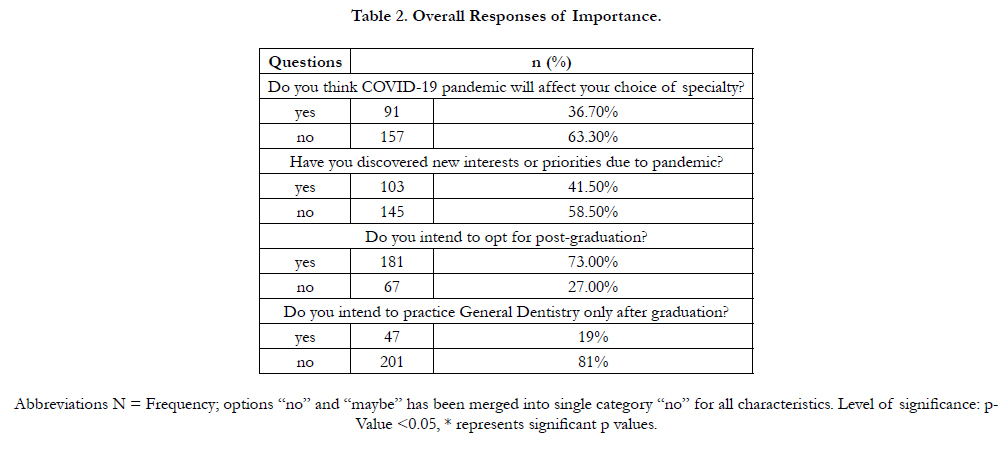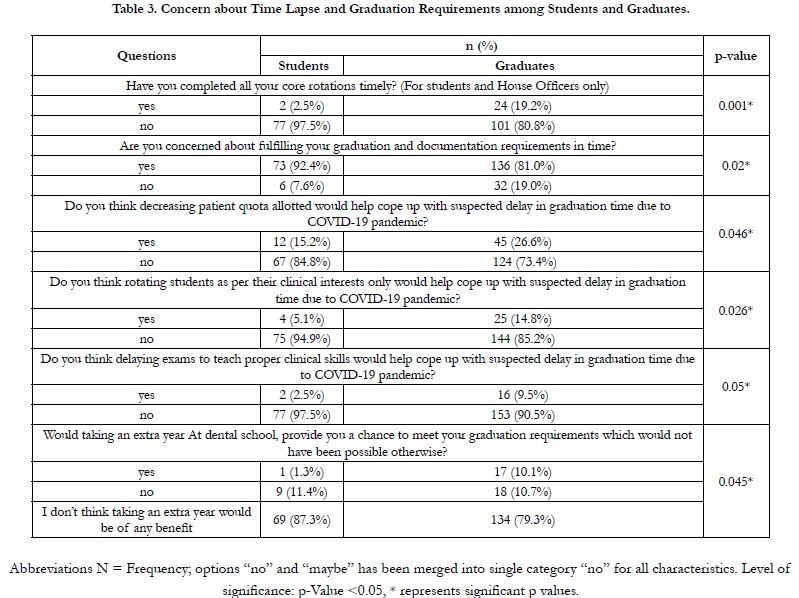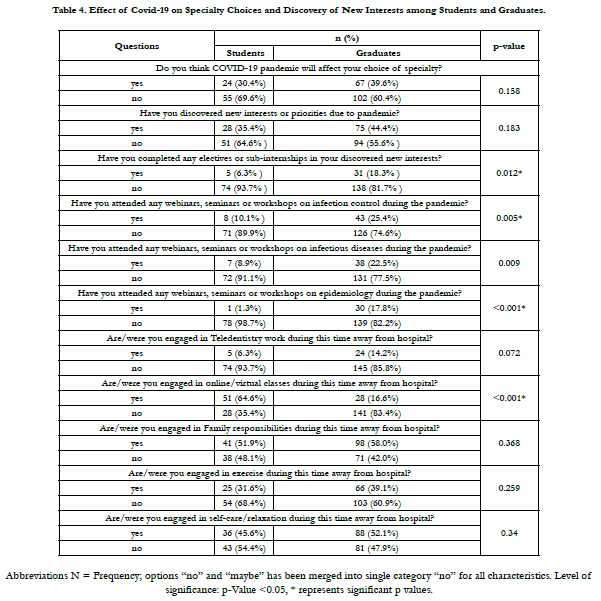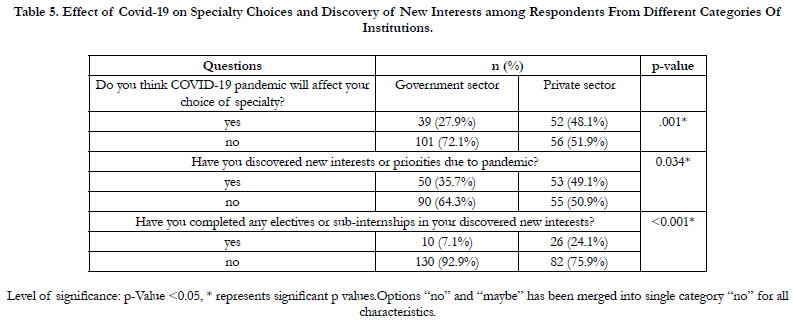Impact of COVID-19 Pandemic Among Dental Students’ And Graduates Post-Graduation Specialty Choices; Amulti-Institutional Survey
Misbah Ashraf Moten1*, AsmaSaher Ansari2, Ume Hani3, Saba Arshad4, Farzeen S. Waseem5, Haifa SaqibBaqai6
1 BDS Lecturer, Department of Oral Biology, Dr. IshratUlEbad Khan Institute Of Oral Health Sciences, Dow University Of Health Sciences, Karachi, Pakistan.
2 MDS, BDS,Assistant Professor, Department of Oral Biology, Dr. IshratUlEbad Khan Institute Of Oral Health Sciences, Dow University Of Health Sciences, Karachi, Pakistan.
3 BDS, Lecturer, Department of Oral Biology, Dr. IshratUlEbad Khan Institute Of Oral Health Sciences, Dow University Of Health Sciences, Karachi, Pakistan.
4 MSc, BDS, Senior Lecturer, Department of Oral Biology, Dr. IshratUlEbad Khan Institute Of Oral Health Sciences, Dow University Of Health Sciences, Karachi, Pakistan.
5 MPhil, BDS, Professor, Department of Oral Biology, Dr. IshratUlEbad Khan Institute Of Oral Health Sciences, Dow University Of Health Sciences, Karachi, Pakistan.
6 MDS, BDS, Assistant Professor, Department of Oral Biology, Hamdard University, Karachi, Pakistan.
*Corresponding Author
Misbah Ashraf Moten,
Lecturer, Department of Oral Biology, Dr. IshratUlEbad Khan Institute Of Oral Health Sciences, Dow University Of Health Sciences, Karachi, Pakistan.
Tel: 03422027407
E-mail: misbah.ashraf@duhs.edu.pk
Received: May 07, 2022; Accepted: June 14, 2022; Published: June 23, 2022
Citation: Misbah Ashraf Moten, AsmaSaher Ansari, Ume Hani, Saba Arshad, Farzeen S. Waseem, Haifa Saqib Baqai. Impact of COVID-19 Pandemic Among Dental Students’ And Graduates Post-Graduation Specialty Choices; Amulti-Institutional Survey. Int J Dentistry Oral Sci. 2022;9(6):5296-5303.
Copyright: Misbah Ashraf Moten©2022. This is an open-access article distributed under the terms of the Creative Commons Attribution License, which permits unrestricted use, distribution and reproduction in any medium, provided the original author and source are credited.
Abstract
Purpose/Objectives: This study evaluated the impact of COVID-19 pandemic on the change in specialty preferences of
dental students and fresh graduates.
Materials And Methods: An analytical cross-sectional study was conducted from Aug’20 to Dec’21using a structured questionnaire,
validated by using pilot sample prior to dissemination to 300 graduating dental students, house officers and graduates
within 5 years of graduation, from different private and public dental schools in Karachi. The survey included questions
regarding interest development towards specialty choices, discovery of new interests, causes of delay in graduation and documentation
and deviations in planned specialty choices due to the circumstances of the pandemic. The data was analyzed using
SPSS version 20.
Results: With an overall response rate of 82.6%, 36.7% of the total respondents perceived an effect of COVID-19 pandemic
on specialty choices, although this impact was found to have no significant association with education status but a significance
in association with categories of institutions was demonstrated, with 48.1% Private sector respondents thinking choice of
specialty would be affected by the pandemic as compared to only 27.9% respondents from Government institutions.
Conclusion: Our results reveal the pandemic has affected post-graduation specialty choices among students and graduates
with discovered new interest and priorities suggest major deflections in planned career paths by decision making dental year
students, house officers and graduates which should be manifested by revising systems of undisrupted curricular, clinical
research and academic activities with timely conduction of examinations and applications.
2.Case Report
3.Discussion
4.Conclusion
5.References
Keywords
COVID-19; Specialties; Dental; Clinical Skills; Career Choice.
Introduction
The declared sixth Public Health of Emergency Services of
International concern (SPHEC) of the COVID-19, by World
Health Organization, found to be caused by a novel severe acute
respiratory syndrome corona virus now known as (SARS-CoV-2),
has led to major socioeconomic chaos worldwide [1, 2]. Unprecedented
transformations in almost all walks of life including religious,
political, cultural, sports, educational, health related or
even activities at state levels have been implicated time to time in
concurrence with the pandemic, including ban or restricted social
gatherings implemented as part of the preventive measure to limit the spread of cases [1, 3].
Educational socializations in Pakistan had been taken into consideration,
in accordance with the needs of time manifested, as
either announcement of complete or partial closure plans in the
National Security Committee (NSC) meeting for schools, colleges,
universities and other centers, leading to educational revolution by
virtual teaching and learning systems as an adaptation to face to
face teaching during the pandemic period, with the commencement
of very first execution plan of lockdown and institutional
closure orders as per WHO guidelines, followed by changing orders
of reopening with SOPs as per HEC permission [4].
With supporting evidence of high transmission risk of the COVID-
19 infection for Dental Health Care Professionals (DHCPs)
including dental students, hygienists, nurses etc. and the recommendation
of Centre of Disease Control and Prevention (CDC)
and American Dental Association (ADA) for restricting dental
activities to emergency cases in April 2020, the dental education
system in Pakistan, by no means, remain unaffected by the closure
of the educational institutions [4-8]. Online teaching methods
through Learning Management Systems (LMS) or other softwarehave
been adopted by the different dental colleges in this stay at
home era [8]. The study for basic dental subjects also appears to
be largely affected by the online system although laboratory procedures,
practical and preclinical exercises have also been affected
to some extent [8, 9].
While still major challenges in the COVID-19 era are to be faced
by students, house officers and fresh graduates who are yet to
enter the practical life with aims of continuing higher education
via application or residency programs or choosing any specialty
for specialization [3]. Third and final year dental students, House
officers and graduates, still awaiting their career pursuance, have
become deprived of external rotation initially with subsequent
re-opening of OPDs and continuation of rotations of students
divided into shifts as per Government orders with strict SOPs in
the clinical departments [10]. The pandemic has reported to affect
the choice of specialty in about one-fifth of the surveyed medical
students in the US as part of a nation-wide survey [3]. Similarly,
with lack of clinical expertise, planned career choices for dental
studentsin the phase of planning for their post-graduation, has
also been shown to be greatly impacted by the on-going pandemic
in a study carried out by the faculty and DMD candidates at
Harvard University Of Dental Medicine Boston, Massachusetts
[11]. To add to the dilemma, an expected lacking in fulfillment
of clinical requirements by third year dental students and postponement
in attempting the licensing exam for the fourth year
students by virtue of the lockdown have also been reported [12].
Although, majorly reported to be a negative view, literature also
reveals, a positive view of Nepali undergraduate dental students
about pursuance of post-graduation courses in future in the ongoing
COVID-19 era, with Oral and Maxillofacial surgery being
the most favorite specialty choice, followed by Operative dentistry,
Pediatric Dentistry, Prosthodontics, Periodontics, Community
Dentistry, Periodontics and Oral Pathology [13].
Studies evaluating career aims from dental students conducted
in Pakistan largely demonstrate, intentions of post-graduation in
clinical subjects via FCPS with only minority being interested in
basic sciences [14]. These locally conducted studies report Oral
and Maxillofacial surgery followed by Orthodontics being chosen
as the most wanted specialty choices with personal interests
being the most common influencing factor [15]. Faisal et al. reported
positive trend for respondents receiving encouragement
from institution to pursue specialization to respond positively for
their desire for post-graduation with Oral Surgery followed by
Orthodontics had been found to be the most preferred choices
and field talent along with desire to study further being the most
chosen reasons for the preferred options [16]. Surprisingly Oral
microbiology or dental radiology as a specialty choice has almost
remained the least preferable domains to pursue post-graduation
throughout literature.
The consequences of the pandemic of COVID-19 undoubtedly
leads to provision of limited exposure, exploration time and experience
status in the core rotations to dental students, house officers
in their relevant fields of interest along with delay in the
graduation time and application processing for residency programs
for all those awaiting to get inducted, therefore the need
to evaluate the impact of the pandemic on future career choices
remains meaningful and lacking to date and to fulfill this research
gap, the aim of the study is to evaluate the impact of COVID-19
pandemic on the change in planned specialty preferences of dental
students and fresh graduates.
Materials And Methods
Study Design, Study setting and Sample
This analytical cross-sectional study was conducted in multiple
Public and Private Dental Colleges of Karachi, Pakistan. Our Target
population constitutes the enrolled students of either third or
final year and House Officers from multiple private and Public
Dental Colleges in Karachi in the year 2020 and Dental Graduates
from 2015 onwards. All participants were asked for verbal consent
prior to questionnaire distribution as well as, written consent
in the form of choosing either “yes” or “no” to an option relating
to permission to proceed in the attached informed consent
form with the survey, was also taken. Dental Graduates working
as General Dental Practitioners, Demonstrators/Lecturers, interns,
or senior House Officers or those who are still awaiting opportunities
to get inducted in any post-graduation programs were
included in the study whereas undergraduate dental students enrolled
either in first or second year, Post Graduate Students, Students
who declined to consent or Dental Graduates with greater
than five years passed after graduation were excluded from the
study.Sample was drawn based on convenience. The sample size
was calculated using an open-epi online calculator version 3.0
with confidence interval of 95% and 80% power of test, a sample
size of three hundred participants has been calculated [3].
Study Tool and Data Collection Procedure
The study tool consisted of a structured, pretested, and validated
questionnaire comprising of fifty three questions. This self-administered
questionnaire was devised with modifications of questions
from a similar study conducted in USA to evaluate the impact
of the pandemic on medical students regarding their career perceptions
[3]. For evaluation of internal consistency of the questionnaire,
the questionnaire was distributed as hard copies to be
filled by almost fifty participants with attached consent form to be
signed by each respondent, prior to distribution of survey forms for the purpose of study, and the value of Crohnbach Alpha was
found to be 0.686, indicating an acceptable level of internal consistency.
Subsequently, data was collected throughout a period of
four months from September’ 20 to December’ 20, from a sample
of two hundred and forty eight participants with informed
consent form by both distribution of survey forms manually
in the form of hard copies to subjects on the basis of convenience
and through the Google survey form (https://docs.google.
com/forms/d/1fH3qAkuocjWbXG9OjUP5E2ad0DWFl-UyC_
HS0wH4wfo/viewform?ts=5f59ef77&edit_requested=true).
The questionnaire consisted of five sections. The first section had
socio-demographic information to be filled, the rest of the questions
were all designed to have either “yes”, “no” and “maybe”
as the options for the possible responses. The second section
pertained to simple questions regarding rotation status, concern
about time-lapse and graduation requirements; followed by a third
section with questions on intended post-graduation program and
specialty of choice. The next two sections had questions regarding
effect of COVID-19 on specialty choices and discovery of
new interests and anticipated reasons for delay in graduation and
documentation time.
Statistical Analysis
Data was analyzed using SPSS version 20. The descriptive statistics
included all independent variables such as age, gender,
education status and category of institution and were reported
as mean and standard deviations for continuous variables such
as age, whereas frequencies and percentages had been calculated
for all categorical variables. For the purpose of evaluation of associations
between variables through Chi-square Statistics, the
categories “Third year” and “Final Year” for the variable Education
Status had been computed as a single category “student”,
similarly “House Officers” and “Graduated and done with House
Job” had been computed as “Graduates”. Also, the response options
“no” and “maybe”, together for all the questions had been
computed as a single category. Cross-tabs had been calculated for
associations between education status and the questions regarding
concern about time-lapse and graduation requirements; postgraduation
trends and specialty choices, and intentions; effect of
COVID-19 on specialty choices and discovery of new interests.
Cross-tabs for category of institution and effect of COVID-19
on specialty choices and discovery of new interests had also been
calculated. A p value of =0.05 was considered significant.
Results and Discussions
Descriptive Statistics
A total of three hundred questionnaires were distributed and a
total of two hundred and forty-eight responses were obtained and
analyzed making an overall response rate of 82.6%. Basic demographics
of the study are given in Table 1.
Overall response of Importance
It can be discerned from the results shown in Table 2, that the
ongoing pandemic would affect choice of specialty making a frequency
of 36.7% of the included data.
Concern about Time Lapse and Graduation Requirements
among Students and Graduates
The X2 statistics for association between education status and
questions regarding concern about time lapse and graduation
requirements (Table 3.) reveal a significant relationship between
core rotation status and education status with most respondents
in both students (97.5%) and graduates (80.8%) haven’t been able
to complete their core rotations timely.
Post-graduation Program and Specialty Choices among Students
and Graduates
It has been revealed that majority of students 70.9% and graduates
50.9% chose “yes” for FCPS or MDS as post-graduation
programs of choice, followed by National Boards/ORE/ADC/
DHA/HAAD/MOH, in which the option “yes” was chosen by
33.10% graduates and 17.7% of students and the least chosen
specialty of choice has been found to be MSc/MCPS/MPhil/
MPH indicated by only 12.7% students and 17.2% of graduates
choosing “yes” for this question. Fig 1 discloses that most popular
specialty choice among students is Operative Dentistry.
Effect of COVID-19 on Specialty Choices and Discovery of
New Interests among Students and Graduates
Table 4 reveals no significant association between education status and impact on specialty choices due to the COVID-19 pandemic
with majority of both students (69.6%, n=55) and (60.4%,
n=102) showing disapproval on this question. Also, a significance
in trends of associations between anticipated reasons for delay
in graduation and documentation time and education status for
“lacking in research” in which majority think it is the reason causing
delay in graduation and documentation time.
Figure 2 shows the most common activity/reason of engagement
during the lockdown period of the pandemic among students has
been found to be online/virtual classes as shown by option “yes”
selected by 64.6% of students for this question, followed by family
responsibilities (51.90%), while for graduates the most common
activity/reason of engagement during the lockdown period
of the pandemic has been shown to be family responsibilities as
demonstrated by selected option “yes” by 58% of graduates followed by self-care/relaxation by 52.1% of the graduates.
Figure 3 demonstrates most common reason for delay in graduation
and documentation time for students has been found to
be “examinations not being conducted on time” for 65.80%,
followed by “being away from rotations” as demonstrated by
49.40% which is further followed by “financial constraints” by
22.80% with lacking in research being the least preferred reason
13.90% whereas similar trend of “examinations not being conducted
on time” followed by “being away from rotations” has
also been observed for graduates with respective frequencies of
57.40% and 54.4%.
Effect of COVID-19 on Specialty Choices and Discovery of
New Interests among Respondents from Different Categories
of Institutions
When evaluating x2 associations for effect of COVID-19 on specialty
choices and discovery of new interests and categories of institutions,
statistically significant result has been obtained for the
association between effect of pandemic on specialty choice and
category of institution with only 27.9% respondents from Government
institutions (n=39) and 48.1% Private sector respondents
(n=52) thinking choice of specialty would be affected by the
pandemic, p-value being 0.001. (Table 5)
This cross-sectional study provides a unique insight to the dental
students and graduates’ problems regarding their future postgraduation
planning, their motivation status and new interests
along with their anticipated reasons and possible suggestions
from their own perspectives, all in this COVID-19 era where
great focus of research has been devoted to addressing different
aspects of psychological impact on dental education and practice
along with economic outcomes [12, 17-19]. To our knowledge,
this survey aims to fulfill the lacking in perceptions from a region
of Asian population of dental students and graduates while a few
USA based studies with somewhat similar aims have been published
[11, 20].
Our study revealed 63.3% of the respondents believe a change in
choice of specialty would result from the pandemic which is quite
high as compared to the study surveying perceptions of dental
students and hygienists surveyed about their perceived change in
future careers where the yielded results were only 10% of the surveyed
population as part of a survey conducted at Virginia Commonwealth
University School of Dentistry [20]. Similarly, Kasey
et. al reported an overall 41% of surveyed dental students believed
the pandemic had affected their career path [11]. Similarly,
medical students surveyed as part of a nationwide survey revealed
only 20.2% respondents thought that the pandemic would affect
their choice [3]. The difference in results can be attributed to regional
differences. Furthermore, this trend of change in specialty
choice in the COVID-19 era did not come out to be significantly
associated in our survey with education status, although a significant association between categories of institution and change in
choice of specialty has been obtained with greater number of respondents
from Private institutions thinking their choices would
be affected as compared to only few respondents from Government
institutions. This difference in perceptions about whether
a change in choice of specialty would occur or not between different
categories of institutions can be explained with a significantly
higher frequency obtained in discovery of new interests
and priorities from respondents from private sector institutions
where almost half respondents have discovered new interest or
priorities as compared to only few respondents from government
institutions.
The significantly higher concerns of both students and graduates
in our study regarding timely completion of graduation and
documentation requirements is consistent with the finding that
42.6% of Higher Education students were found almost all time
worried about their future professional career as part of a global
survey conducted to evaluate the impact of COVID-19 Pandemic
on life of Higher Education Student [21]. Also an exploratory
study, surveying impact of the critical era of pandemic on dental
healthcare utilization and economics, reported an expected lacking
in fulfillment of clinical requirements by third year dental students
and postponement in attempting the licensing exam for the
final year students by virtue of the lockdown in the US [12]. This
reasonably explains the anticipated delay in graduation and documentation
time for students and graduates for their future careers.
Our study highlights “examinations not being conducted on time”
as the most anticipated reason for the expected delay in graduation
and documentation time due to the pandemic, followed by
“being away from rotations” and “not being able to get letters
of recommendation”which somehow relates with most commonly
concerned reasons of about ‘letters of recommendation’
and ‘being away rotations’ followed by “taking board exams” in a
nationwide survey evaluating impact of the pandemicon medical
students [3]. The possible explanation for the most anticipated
reason being “examination not being conducted on time” could
be in a developing country in which the study has been conducted,
lack of preparedness by educational institutions at such a time
of crisis for online systems or evaluation and teaching modes possibly
explain the highlighted the reason.
Financial concerns and reasons for delay in either graduation and
documentation hasn’t been a popular anticipated reason in our
study which is found to be greatly inconsistent with literature
where a lot of studies in the COVID-19 era has indicated undergraduate
students are concerned greatly about their future careers
and education [21]. Maschadoet. al hypothesized an expected decrease
in the number of students enrolled in dental college by
dropout of students as part of financial crises by the by virtue of
the COVID-19 pandemic where many students depend on job in
a study conducted in Brazil [22].
Also consistent with the finding that 41.5% respondents have
discovered new interest or priorities during the pandemic in our
survey, several respondents were also found to develop alternative
career plans during the ongoing pandemic as part of the survey
conducted in a region of USA which targeted dental students and
hygienists [20]. Also depicting literature, our study indicated a majority
of both students and graduates having an intention to opt
for post-graduation while also the popularity of practicing general
dentistry only after graduation in private set-ups has also been
found to be very low, which finds consistency in several studies
conducted both in the pre-pandemic and during the pandemic era
[16, 20, 23].
Regardless of the pandemic, post-graduation program of choice
chosen by the respondents of this survey highlights FCPS or
MDS as the most preferred programs of choice which undoubtedly
is consistent with many previous regional studies owing to the
mindset of the majority of students and graduates who intend to
stay in their country and achieve their clinical specialization goals
with the best of the available options [14, 15]. Furthermore, our
study demonstrates Operative dentistry for students and Oral and
Maxillofacial Surgery for graduates as the most preferred specialty
choices, followed alternately as OMFS for students and Operative
Dentistry for graduates as the second most preferred choices,
while Orthodontics has been found as the third preferred choice
for both, this somehow contrasts literature to some extent where
OMFS followed by Orthodontics remain the most preferred as
indicated by several regional studies whereas the popularity of
Orthodontics has been demonstrated by several international
studies [15, 16, 18, 24-26].
When asked about activities engagement during the time of being away from hospital, our survey revealed “online/virtual classes”
followed by “family responsibilities” for students whereas “family
responsibilities” followed by “self-care/relaxation” for graduates,
has been found to be consistent with “research’ and ‘virtual classes
through medical school’ as being the activities medical students
were engaged in, when evaluating impact of pandemic on medical
students in USA [3]. The unpopular activity “research” with a low
frequency in our study, reveals the lack of encouragement and
interests of students and graduates in the region with even postgraduation
program applications also fail to put much emphasis
on such an important aspect of scientific growth.
Strengths of the research include an adequate sample size to address
the aim with a fair response rate. Along with addressing
the main aim, this survey also tries to find out aboutdiscovery
of new interests also with some questions trying to rule out any
anticipated reasons and suggestions pertaining to time lapse and
delay in graduation and documentation, particular to the settings
of dentistry holding an appropriate importance regionally and can
be used in further research. With a very concise international literature
being available with this particular aim, our study paves
way tomany researches with modifications both on a regional and
international level.
Limitations of the study include a lack of comparison between
pre and post pandemic specialty choices with a simpler study design.
Also, a lacking in comparison between pre and post pandemic
factors affecting specialty choices can be discerned.
Figure 1: Post-Graduation Specialty of choice among students and graduates. Percentage comparison for respondents choosing “yes” when asked about Multiple Post-Graduation specialties of choice among Students and Graduates.
Figure 2. Most common activity/reason of engagement during the lockdown period of the pandemic among students and graduates. Percentage comparison for respondents choosing “yes” when asked about multiple activities/reasons of engagement during lockdown period among Students and Graduates.
Figure 3. Most common cause of delay in graduation and documentation among students and graduates. Percentage comparison for respondents choosing “yes” when asked about multiple activities/reasons of engagement during lockdown period among Students and Graduates.
Table 4. Effect of Covid-19 on Specialty Choices and Discovery of New Interests among Students and Graduates.
Table 5. Effect of Covid-19 on Specialty Choices and Discovery of New Interests among Respondents From Different Categories Of Institutions.
Conclusion
Since our findings indicate a major impact of the pandemic on
post-graduation specialty choices along with deviations in career
paths being suggested by alternately discovered new interests and
priorities by some of the study participants signals major challenges
to be faced by educational institutions in this COVID-19
era to fulfill their provisional requirements for their students,
facilitating improvements in their disrupted clinical rotations,
examinations and post-graduation applications and requisitions
and hence their preparedness for continuation of all the routine
proceedings. Furthermore, more precise, and improvised work
related to addressing future concerns for careers in the discipline
of dentistry related to residency programs, especially in the COVID-
19 era is anticipated.
Acknowledgements And Declarations
We acknowledge Ms. Sidra Zaheer, senior lecturer and biostatistician
at School of Public Health, Dow University of Health Sciences
for her contribution in statistical work of this study. There
are no conflicts of interest associated with our research article and
no funding or grants were provided for this study.
References
-
[1]. Sarwar S, Waheed R, Sarwar S, Khan A. COVID-19 challenges to Pakistan:
Is GIS analysis useful to draw solutions? Sci Total Environ. 2020 Aug
15;730:139089. PubMed PMID: 32387823.
[2]. Waris A, Atta UK, Ali M, Asmat A, Baset A. COVID-19 outbreak: current scenario of Pakistan. New Microbes New Infect. 2020 Apr 14;35:100681. PubMed PMID: 32322403.
[3]. Byrnes YM, Civantos AM, Go BC, McWilliams TL, Rajasekaran K. Effect of the COVID-19 pandemic on medical student career perceptions: a national survey study. Med Educ Online. 2020 Dec;25(1):1798088. PubMed PMID: 32706306.
[4]. Iqbal SA, Ashiq M, Rehman SU, Rashid S, Tayyab N. Students’ Perceptions and Experiences of Online Education in Pakistani Universities and Higher Education Institutes during COVID-19. J Edu Sci. 2022 Feb 28;12(3):166.
[5]. Zemouri C, de Soet H, Crielaard W, Laheij A. A scoping review on bioaerosols in healthcare and the dental environment. PLoS One. 2017 May 22;12(5):e0178007. PubMed PMID: 28531183.
[6]. Kowalski LP, Sanabria A, Ridge JA, Ng WT, de Bree R, Rinaldo A, et al. COVID-19 pandemic: Effects and evidence-based recommendations for otolaryngology and head and neck surgery practice. Head Neck. 2020 Jun;42(6):1259-1267. PubMed PMID: 32270581.
[7]. Iyer P, Aziz K, Ojcius DM. Impact of COVID-19 on dental education in the United States. J Dent Educ. 2020 Jun;84(6):718-722. PubMed PMID: 32342516.
[8]. Haroon Z, Azad AA, Sharif M, Aslam A, Arshad K, Rafiq S. COVID-19 Era: Challenges and Solutions in Dental Education. J Coll Physicians Surg Pak. 2020 Oct;30(10):129-131. PubMed PMID: 33115587.
[9]. Majeed MM, Durrani MS, Bashir MB, Ahmed M. COVID-19 and Dental Education in Pakistan. J Coll Physicians Surg Pak. 2020 Oct;30(10):115- 117. PubMed PMID: 33115583.
[10]. Wu DT, Wu KY, Nguyen TT, Tran SD. The impact of COVID-19 on dental education in North America-Where do we go next? Eur J Dent Educ. 2020 Nov;24(4):825-827. PubMed PMID: 32654328.
[11]. Ha K, Lee A, Aram A, Ohyama H. Dental student perspective on postgraduation planning in the COVID-19 era panel. J Dent Educ. 2020 Nov 3. PubMed PMID: 33145773.
[12]. Patel N.Impact on Dental Economics and Dental Healthcare Utilization in COVID-19: An Exploratory Study. J Adv Oral Res. 2020;11(2):128-36.
[13]. Garg D, Kapoor D. Perception of Dental Students of COMS-TH regarding Future of Dentistry in Nepal amid COVID-19 Pandemic. JNMA J Nepal Med Assoc. 2020 Sep 27;58(229):677-680. PubMed PMID: 33068090.
[14]. Yousuf W, Kazmi SMR, Quraeshi S, Khan M. Motivation and Future Intentions of Dental Students in Karachi, Pakistan. Pak J Med Res. 2019;58(1):26.
[15]. Kashif M, Shaikh A, Najmi N, Iqbal A. Dental Post Graduate Educational Programmes Preferences in Pakistan and Factors Affecting it: A Cross Sectional Survey Conducted at Karachi, Pakistan. Pak J Med Res. 2019;58(2).
[16]. Faisal MR, Mehmood B, Pash L, Siddiqa F. ATTITUDES OF FINALYEAR DENTAL STUDENTS TOWARDS CAREER DEVELOPMENTA CROSS-SECTIONAL SURVEY. Cell. 2017;346:9646261.
[17]. Sarwar H, Akhtar H, Naeem MM, Khan JA, Waraich K, Shabbir S, Hasan A, Khurshid Z. Self-Reported Effectiveness of e-Learning Classes during COVID-19 Pandemic: A Nation-Wide Survey of Pakistani Undergraduate Dentistry Students. Eur J Dent. 2020 Dec;14(S 01):S34-S43. PubMed PMID: 33003240.
[18]. Fita S, Alshuraim F, Almulhim A, AlHumaid J, Alhareky M, Nazir M. Possible Future Career Challenges and Associated Factors among Dental Students and Interns. Int J Dent. 2020 Apr 9;2020:9730125. PubMed PMID: 32351570.
[19]. Raja HZ, Saleem MN, Saleem T, Rashid H, Ehsan S, Hakeem S, et al. Perceived stress levels in Pakistani dental students during COVID-19 lockdown. EJDENT. 2020;1(4).
[20]. García DT, Akinkugbe AA, Mosavel M, Smith CS, Brickhouse TH. COVID- 19 and Dental and Dental Hygiene Students' Career Plans. JDR Clin Trans Res. 2021 Apr;6(2):153-160. PubMed PMID: 33403913.
[21]. Aristovnik A, Keržic D, Ravšelj D, Tomaževic N, Umek L. Impacts of the COVID-19 pandemic on life of higher education students: A global perspective. Sustainability. 2020 Oct 13;12(20):8438.
[22]. Machado RA, Bonan PRF, Perez DEDC, Martelli JÚnior H. COVID-19 pandemic and the impact on dental education: discussing current and future perspectives. Braz Oral Res. 2020 Jun 29;34:e083. PubMed PMID: 32609144.
[23]. Shin JH, Kinnunen TH, Zarchy M, Da Silva JD, Chang BM, Wright RF. Factors influencing dental students' specialty choice: a survey of ten graduating classes at one institution. J Dent Educ. 2015 Apr;79(4):369-77. Pub- Med PMID: 25838007.
[24]. Lee Y, Ross AJ. Projected speciality career choices among undergraduate dental students in Scotland. Br Dent J. 2018 Jan;224(1):32-37. PubMed PMID: 29192687.
[25]. Dhima M, Petropoulos VC, Han RK, Kinnunen T, Wright RF. Dental students' perceptions of dental specialties and factors influencing specialty and career choices. J Dent Educ. 2012 May;76(5):562-73. PubMed PMID: 22550102.
[26]. Alrashdan MS, Alazzam M, Alkhader M, Phillips C. Career perspectives of senior dental students from different backgrounds at a single Middle Eastern institution. BMC Med Educ. 2018 Nov 26;18(1):283. PubMed PMID: 30477562.

